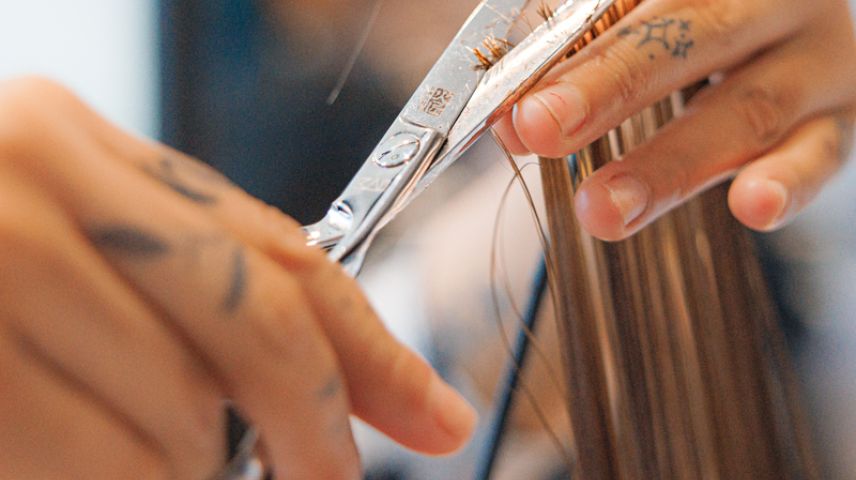Chemotherapy and Hair Loss

You might not think about how important your hair is until you face losing it. And if you have cancer and are about to undergo chemotherapy, the chance of hair loss is very real. Both men and women report hair loss as one of the side effects they fear most after being diagnosed with cancer.
Whether or not you experience hair loss from your chemotherapy treatment depends mostly on the type and dose of medication that you receive. But whether you can maintain a healthy body image after hair loss depends a lot on your attitude and the support of your friends and family.
Why does hair loss occur with chemotherapy?
Chemotherapy drugs are extremely powerful medications that attack rapidly growing cancer cells in your body. Unfortunately, these drugs also attack other rapidly growing cells in your body - including those in your hair roots.
Chemotherapy treatment, therefore, may cause hair loss all over your body - not just on your scalp. Sometimes your eyelash, eyebrow, armpit, pubic and other body hair also falls out. Some chemotherapy drugs are more likely than others to cause hair loss, and different doses can cause anything from a mere thinning to complete baldness. Talk to your doctor or nurse about the medication you will be taking during your treatment so that you can be fully informed as to what to expect.
Fortunately, the good news is that most of the time hair loss from chemotherapy is temporary. You can expect to regrow your hair three to ten months after your treatment ends; you could find that your hair may temporarily grow back in a different shade or texture.
What should you expect?
You will find that your hair usually begins falling out one to three weeks after you start treatment. It could fall out very quickly in clumps or gradually. We are all individuals and there is no hard rule when it comes to hair loss. You will likely notice the accumulation of loose hair on your pillow in the morning, in your hairbrush or comb, or in your sink or shower drain. Your scalp may also feel quite tender.
Some of our clients chose to cut their hair shorter before their treatment begins so they see their hair loss when it happens as less traumatic. Some of our clients chose not to. Some of our clients decide to purchase a wig before their hair loss begins, some chose to purchase a wig after their hair loss has started. Some of our clients chose to purchase a wig that is very similar to their current hair colour and style some of our clients chose a completely different colour and style of wig. Your hair loss will continue throughout your treatment and up to a few weeks afterward. Whether your hair thins or you become completely bald will depend entirely upon your treatment program.
It may take several weeks after your treatment has finished for your hair to recover and begin growing back again. When your hair starts to grow back, it will probably be slightly different from the hair you lost. But the difference is usually only temporary. Your new hair might have a different texture or be a different colour. You may find that it is curlier than it was before, or it could be grey until the cells that control the pigment in your hair begin functioning properly again.
Can hair loss be prevented when having chemotherapy?
There are several treatments you may have heard about that have been investigated as possible ways to prevent hair loss, but none has been absolutely effective, including:
- Scalp hypothermia (cryotherapy). During your chemotherapy treatment, ice packs or similar devices are placed on your head to slow down the blood flow to your scalp. This way, chemotherapy drugs are less likely to have an effect on your scalp. Studies of scalp hypothermia have found it works somewhat in the majority of people who have tried it. However, the procedure also causes a small risk of cancer recurring in your scalp, as this area doesn’t receive the same dose of chemotherapy as the rest of your body. People undergoing scalp hypothermia report feeling uncomfortably cold and having headaches during treatment. Here at Crowning Glory at Simone Thomas Salon we advise that you speak with your doctors and nurses regarding this method and whether it is right for you.
- Minoxidil (Rogaine). Applying minoxidil - a drug approved for pattern hair loss in men and women - to your scalp before and during chemotherapy isn’t likely to prevent your hair loss, although some research shows it may speed up your hair regrowth after your treatment has been completed. Here at Crowning Glory we stress that more research is needed to understand whether minoxidil is effective in regrowing hair after cancer treatment has been completed. It is wise that you discuss this with your doctors during your consultations.
How to make the best of it?
By taking the following steps throughout your chemotherapy treatment hopefully the frustration and anxiety associated with hair loss can be minimised.
Before your treatment:
- Be gentle to your hair. Get in the habit of being kind to your hair. Don't bleach, colour or perm your hair - this can weaken it. Stay away from hairdryers, instead air-dry your hair as much as possible and avoid heating devices such as curling tongs, straighteners and hot rollers. Strengthening and nourishing your hair and scalp now might make it more likely to stay in your head a little longer during treatment.
- Consider cutting your hair. Short hair tends to look fuller than long hair. So as your hair falls out, it won't be as noticeable if you have short hair. Also, if you have long hair, going short might help you make a better transition to total hair loss. Concentrate on keeping yourself as healthy as possible and keeping stress to a minimum.
- Plan for a head covering. Now is the time to start thinking about wigs, scarves or other head coverings. Whether you choose to wear a head covering to conceal your hair loss is up to you. But it's easier to plan for it now rather than later. There are some fantastic high quality synthetic wigs and real hair wigs on the market - the myth that wigs are cheap and tacky looking has been well and truly busted here at Crowning Glory.
During your treatment:
- Baby your remaining hair. Continue your gentle hair strategies throughout your chemotherapy treatment. Use a soft brush – get yourself a soft baby brush. Wash your hair only as often as is necessary. Consider using a gentle shampoo free from parabens and chemicals.
- Consider shaving your head. Some people report that their scalps feel itchy, sensitive and irritated during their treatment and whilst their hair is falling out. Shaving your head can reduce the irritation and save the embarrassment of shedding. Some men shave their heads because they feel it looks better than the patchy hair loss they might be experiencing.
- Protect your scalp. If your head is going to be exposed to the sun or to cold air, protect it with sunscreen or a head covering such as a scarf or a wig. Your scalp may be sensitive as you go through treatment, so extreme cold or sunshine can easily irritate it. Having no hair or having less hair can make you feel cold and vulnerable, so a head covering may make you more comfortable and less stressed out by the thought that people may be staring at you.
After your treatment:
- Continue with your gentle haircare routine. Your new hair growth will be especially fragile and vulnerable to the damage caused by styling products and heating devices. Hold off on colouring or bleaching your new hair until it grows stronger. Processing your new hair growth could damage your hair and irritate your sensitive scalp.
- Be patient. It's likely that your hair will grow back slowly and that it might not look normal right away. It could grow back a different colour or texture. Four to six months after your treatment has finished you should expect to see a healthy head of hair. If you previously have straight hair it could grow back curly. New growth takes time, and it also takes time to repair the damage caused by your cancer treatment.
Cover your head
For many women hair is associated with femininity and health, so they choose to maintain that look by wearing a wig. Others choose hats and scarves. Still others choose not to cover their heads at all. It really is a personal preference.
Take a look at the Look Good... Feel Better website - this is a free resource online and at many hospitals throughout the UK that provides hair and beauty makeovers and tips to women with cancer. Look Good... Feel Better also offers classes for teens with cancer, as well as a website especially for men.
There are a lot of ways to cover your head if your hair falls out during treatment. A wig is the most obvious choice. But not everyone wants to wear a wig. They can be a bit hot, especially in the summer months. Younger people often prefer hats, scarves or baseball caps. Or you can just leave your head uncovered if you feel confident with your bald head. Everyone is different and it really is much more to do with personal preference.
If you think you would like to wear a wig then it is better to start the process before you start to lose your hair. Some people (but not all) can get a wig on the NHS. If you want to match your own hair colour and style (and not everyone does) it's best to start the wig buying process as soon as you know you will be having cancer drugs that cause hair loss.
If you are feeling adventurous then perhaps you may want to chose a wig for a whole new look, a new colour and style, the hairstyle you have always dreamed about - buying a wig really can be fun - it doesn’t have to be a daunting experience.
Radiation therapy can also cause hair loss
Radiation therapy also attacks quickly growing cells in your body, but unlike chemotherapy, it affects only the specific area where treatment is concentrated. If you have radiation to your head, you will be likely to lose the hair on your head.
Your hair usually begins growing back after your treatment ends. But whether it grows back to its original thickness and fullness depends on your specific treatment. It may also grow back curly or a different colour initially. Different types of radiation and different doses will have different effects on your hair. Higher doses of radiation can cause permanent hair loss. Talk to your doctor about what dose you'll be receiving so that you'll know what to expect. Then you can start planning, but more importantly begin to stress less on the possibility of losing your hair if you have a plan in place.
Radiation therapy also affects your skin. The treatment area is likely to be red and may look sunburned or tanned. If your radiation treatment is to your head, it's a good idea to cover your head with a protective hat or scarf because your skin will be sensitive to cold and sunlight. Synthetic wigs and real hair wigs can also be worn with a protective wig cap to help alleviate any scalp irritation.
If you are thinking that you may wish to wear a wig during this temporary hair loss, please feel free to book a free consultation with one of our hair loss specialists here at Crowning Glory at Simone Thomas Salon. We hold a vast array of synthetic wigs and real hair wigs in a huge variety of styles and colours.
We have a clinic you can visit with a friend or family member where you can discuss the options you have available in a friendly and relaxed environment with people who understand and have experience of what you are going through. You can try on a wide variety of wigs and scarves to help you decide how you are going to deal with the very real trauma of losing your hair during your chemotherapy treatment.





